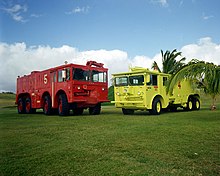Four Wheel Drive

The Four Wheel Drive Auto Company, more often known as Four Wheel Drive (FWD), was founded in 1909 in Clintonville, Wisconsin, as the Badger Four-Wheel Drive Auto Company by Otto Zachow and William Besserdich.[1]
History

Zachow and Besserdich developed and built the first successful four-wheel drive (4x4) car, the "Battleship", in 1908. Its success led to the founding of the company. "Badger" was dropped from the name in 1910.[2]
The success of the four-wheel drive in early military tests prompted the company to switch from cars to trucks. In two world wars, U.S. and Allied armies depended on such four-wheel drive vehicles.[3] A Model 1917 U.S. Army truck survives in working condition at the Fort MacArthur Military Museum, San Pedro, Los Angeles, California.
FWD vehicles were made with a track width of 4 ' 8½" so they could quickly be used on a standard gauge railway line merely by changing the wheels.
A Canadian subsidiary was set up in conjunction with Dominion Truck of Kitchener, Ontario by 1919.
A British subsidiary was set up at Slough in 1921. In 1926, the British FWD, also known as the Quad, was produced with a larger 70 bhp engine.
A relationship with premier race car constructor Harry Miller resulted in the Four Wheel Drive Miller that competed successfully at Indianapolis in 1931 and later. This car, with lockable center differential, is arguably the first modern all wheel drive car. One example survives and has competed in premier vintage race car meets such as the Goodwood Festival of Speed. "The Last Great Miller" by Griffith Borgeson gives a complete history of this landmark car.
In 1932, AEC took a controlling interest in the British company and began to use more standard AEC components in the Slough-built vehicles. To distinguish these from imported U.S. FWD vehicles, they were marketed under the name Hardy. Production ceased about 1936, but AEC exploited its experience with all-wheel drive in its Second World War Matador (4x4) and Marshall (6x6) vehicles.

In 1958, the company's name was changed to FWD Corporation.
In 1963, FWD acquired Seagrave Fire Apparatus who then moved from their old location in Columbus, Ohio, to their current location at FWD in Clintonville, Wisconsin. Many tower ladders in the 1990s using Seagrave chassis were branded as FWD. They used Baker Aerialscopes for the boom which FWD had also acquired over the years along with Almonte Fire Trucks.
Randolph Lenz, Chair of FWD's parent company, Corsta Corp., became embroiled in a Federal Deposit Insurance Corporation suit and in 2003 all assets of FWD: FWD Corporation, Seagrave, Baker Aerialscope and Almonte Fire Trucks were sold to an investment group headed by former American LaFrance executive James Hebe. Today, the Seagrave group is a flagship company of ELB Capital Management.
See also
- G-numbers, (SNL G174)
- Luella Bates first licensed woman truck driver employed by the Four Wheel Drive Auto Co. 1918-1922.
References
- ^ Borth, Christy. Masters of Mass Production, pp. 210-14, Bobbs-Merrill Co., Indianapolis, IN, 1945.
- ^ Borth, Christy. Masters of Mass Production, pp. 210-14, Bobbs-Merrill Co., Indianapolis, IN, 1945.
- ^ Borth, Christy. Masters of Mass Production, pp. 212-14, Bobbs-Merrill Co., Indianapolis, IN, 1945.
External links
- http://www.eliason-snowmobile.com/ early product.
- https://archive.org/details/americasmunitio01deptgoog early vehicles
- http://www.landships.freeservers.com/new_pages/fwd_truck_info.htm liberty truck
- http://www.mace-b.com/38TMW/Missiles/MM-1.htm teracruzer
